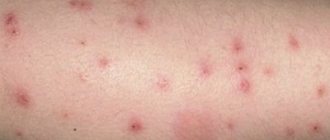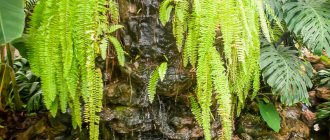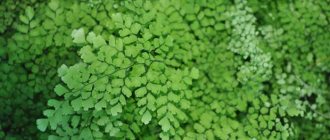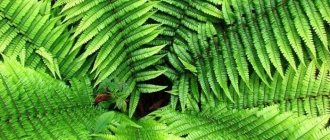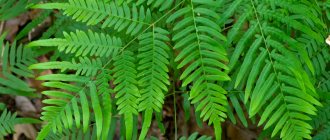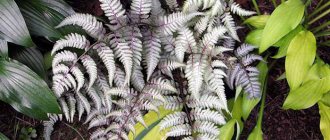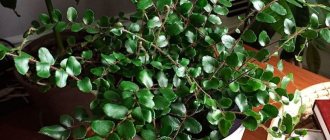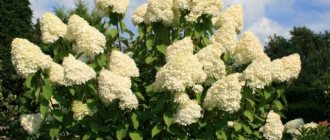Loading…
Loading…
The evergreen fern polypodium is an epiphytic plant, so it thrives without soil. Able to cling to tree trunks and branches. Only two species are bred indoors. One of them is golden. Its carved foliage has a bluish tint. Young shoots are presented in the form of single leaf blades. As they get older, they divide into three lobes. When mature, the fronds resemble the branches of a palm tree.
The fluffy crown of a herbaceous plant in wide pots looks original. The root system of the crop is so creeping that it grows at lightning speed over large areas.
Description
Depending on the growing zone, ferns of the Polypodium species are evergreen or deciduous. All varieties are characterized by a thick, creeping rhizome covered with numerous scales.
From it grow two rows of leathery, carved leaves on long petioles, which, when they die, leave behind stalk-like scars.
The plant got its name for this feature - translated it means “many legs.”
The bright greenery of the fern is very diverse. Leaves or fronds can be entire, pinnately dissected or doubly pinnate in shape.
There are specimens with miniature foliage no more than 10 cm in length and huge spreading representatives of the flora with half-meter fronds.
On the lower part of the leaf blade there are rounded yellow-orange growths - these are sporangia that form spores. In an apartment, polypodium sporulates extremely rarely. Some varieties of the centipede have recently been classified by botanists as belonging to its closest relative, the genus Phlebodium.
With proper care, polypodium lives in an apartment for many years, producing several new leaves every year. It looks very impressive in floor and hanging flowerpots. This is a luxurious decoration for apartments, balconies, winter gardens and home greenhouses.
Treatment methods
When choosing treatment methods and drawing up a treatment regimen, the doctor must take into account the form of the disease, the degree of development, and the intensity of the symptoms. To draw up a treatment regimen, a consultation of several specialized specialists is usually required - a neonatologist, neurologist, neurosurgeon, orthopedist. The main objectives of therapeutic interventions are:
- Improving motor activity;
- Increased strength and level of motor activity in those limbs affected by pathology;
- Preventing possible complications;
- Self-care and social adaptation of the baby.
Surgical intervention
When fighting myelodysplasia, surgical intervention is necessary to get rid of congenital disorders; plastic surgery and elimination of intervertebral hernia are also performed. Emergency intervention is necessary in a situation where the spinal membranes rupture. It is often accompanied by heavy bleeding and leakage of liquorrhea.
The duration of rehabilitation after surgery is determined by the effectiveness of the operation itself and the elimination of neurological symptoms.
Medications
The use of different medications is an important step in the treatment of a disease such as myelodysplasia. If there are signs such as paresis of the limbs, the following medications are usually prescribed - Proserin, Galantamine. The purpose of these medications is to increase the tone of the muscular system. A course of therapy is carried out using muscle stimulants. Its duration is at least three weeks, after which they take a break and resume the course of therapy again.
When there is an increased content of spinal exudate in the brain, dehydration drugs (Diacarb, magnesium sulfate) are used. It is mandatory to take Asparkam, the task of which is to maintain the optimal level of potassium in the body. With the help of Cerebrolysin and Piracetam, the activity of the central nervous system is regulated. It is almost always mandatory to take medications belonging to group B. When prescribing any medications, the age, severity of the disease, and body weight of the baby should be taken into account.
Non-drug treatment
Additional procedures are an integral part of the treatment of myelodysplasia. All methods are prescribed only by a doctor, taking into account the degree of pathology and severity of the condition.
- Also on NewsForever.ru: treatment of lumbosacral radiculopathy
The following therapeutic measures are used:
- Therapeutic exercise plays a positive role in the treatment of children whose condition is aggravated by paresis or paralysis. Passive manipulations are used, which smoothly transition to active actions. It is recommended that parents undergo training in the basics of physical therapy so that they can teach the child the necessary gymnastics;
- The use of therapeutic massage is advisable in the presence of lesions in the limbs. Also, such procedures strengthen the tone of the muscular system, have a positive effect on the condition of the musculoskeletal system, and stretch the affected vertebra;
- Physiotherapy, which includes magnetic therapy, electrophoresis, ultrasound.
The massage will be carried out by parents independently at home, having previously received training from a doctor.
Kinds
Golden
The most common type in indoor floriculture. It is distinguished by beautiful pinnately lobed fronds of a bluish color, which is given to them by a waxy coating that protects them from dry air and pests. The length of the fronds reaches 1 meter or more.
The rhizome is covered with numerous golden-brown hairs.
On its basis, very decorative varieties “Mandaianum”, “Cristatum”, “Glaucum crispum”, “Glaucum” were bred.
Photo of the Golden subspecies:
Multiple
A very spectacular and bizarre fern with large fronds growing from the same rhizome, but different in shape. Each of them is original and one of a kind. You can see the shape with solid, wavy, split or corrugated edges. Moisture usually collects in leaf rosettes, which helps to easily transfer dry indoor air.
Photo of the subspecies Multiple:
Virginia
A small centipede with narrow pinnate leaves no more than 30 cm long and 6 cm wide. Each frond segment has slightly jagged edges.
Photo of the Virginian subspecies:
Pimply
A very decorative variety. It is distinguished by the pimpled surface of dark green, pinnately dissected leaves. When dried, they emit a subtle smell of coumarin.
Photo of the subspecies Pimply:
Austrian, cambric or southern
A species with deltoid pinnately divided fronds reaching half a meter in length. The segments of the leaf blades are lanceolate and serrate along the edge.
Photo of the Austrian subspecies:
West
A miniature variety with ascending fronds no more than 20 cm long. Narrow segments are entire, elliptical or jagged. This is a frost-resistant fern that can withstand cold temperatures down to -29 °C.
Photo of the Western subspecies:
Ussuri or linear
An epiphyte growing on tree trunks and in rock cracks. The dark green leaves are entire, linear-lanceolate in shape. Interestingly, in dry weather they curl up into a tube. The rhizome is covered with a brownish-black film. It is grown on rocky hills and in rock gardens.
Photo of the Ussuri subspecies:
Californian
Deciduous fern with narrow oval leaves of pinnately dissected shape. The segments are linear-oblong and membranous. This representative of the flora is suitable for growing only in open ground.
Photo of the Californian subspecies:
Skulera
A spectacular tufted fern with very wide glossy fronds of gray-green color. Their shape is pinnate or pinnately dissected. The feathers of the leaf plate are also wide.
Photo of the Skulera subspecies:
Serrated
It is interesting for its rather large deltoid fronds with long segments, jagged or serrated along the edges, which gives the plant an openwork appearance. Its petioles are very long, almost equal to the length of the leaf.
Photo of the Serrated subspecies:
Ordinary
The only epiphytic fern growing in central Russia. This is a rare plant found on mossy stones and rocky crevices. Its leaves are leathery and palmately compound. The rhizome has a sweet taste, which is why it is popularly called “sweet root.” A very frost-resistant species that can withstand temperatures down to -40 °C.
Photo of the subspecies Ordinary:
You can learn more about common types of ferns here.
Prevention
To reduce the risk of congenital developmental anomalies in a child, it is recommended to take measures. A pregnant woman should eat a full and balanced diet, and be sure to exclude negative addictions. The use of oral medications is as prescribed by a doctor.
It is very important to monitor the condition during pregnancy and prevent the risk of an intrauterine infectious process.
- Also on NewsForever.ru: Violation of the statics of the lumbosacral spine.
By eliminating all predisposing factors that negatively affect the development of the fetus, the risk of congenital pathologies in the baby can be reduced.
Features of home care
Polypodium is considered the most picky of all ferns. It thrives indoors and grows quickly to form a lush bush of green, feathery leaves. The correct watering regime and high humidity are the main requirements it makes.
Lighting
The plant prefers light partial shade without exposure to direct rays of the sun, which leave burns on it. The eastern, western and northern sides are the optimal locations for its placement.
The location on the southern window sill will require shading with a light curtain. You can place the fern in the back of a bright room or in a sunny area, but under the cover of a larger plant.
Temperature
In the spring-summer season, polypodium likes regular room temperature.
In winter, it prefers temperatures from 14 to 20 °C, while the fastidious centipede prefers temperatures from 12 to 14 °C.
At this time, it is important to protect the fern from drafts and hypothermia of the roots.
It is also very advisable to place it away from heating appliances.
Watering and humidity
Water the plant sparingly after the top layer of soil becomes dry. For this representative of the flora, both over-drying of the earthen clod and over-moistening, which provokes rotting of the roots, are equally harmful. Water for irrigation should be soft and sufficiently settled.
Polypodium needs high air humidity. He loves daily sprays and occasional showers. You can place the pot on a tray with wet pebbles so that the water level is below the bottom of the pot.
The centipede will respond gratefully to rubbing the leaves with a damp sponge. However, the golden polypodium will not like this procedure - its fronds are covered with a waxy coating, which may be damaged.
Fertilizers (feeding)
The plant should be fertilized very carefully. From May to the end of August, 2 feedings with a mineral complex per month are sufficient.
The concentration of fertilizers should be 4 times weaker than indicated in the instructions. In winter, fertilizing is canceled.
Replanting and soil composition
The polypodium is replanted in spring or summer as it grows, when the rhizome fills the entire volume of the pot. The container required is wide and shallow. In addition, the green pet must be provided with good drainage.
When replanting, you should not deepen the rhizome too much - you just need to press it lightly and sprinkle it with a little soil on top. Elongated shoots can be cut off and used for propagation.
The soil should be loose and breathable with a slightly acidic reaction. You can prepare a substrate from equal parts of leaf humus, crushed pine bark and sphagnum. This composition is good for epiphytic ferns. And for all types of centipedes, a mixture prepared from 2 parts of leaf soil, to which is added 1 part each of coniferous soil, peat, humus and coarse sand, is suitable.
Features of care after purchase
A polypodium that comes into the house from a flower shop must be carefully inspected to make sure that there are no pests on it, and placed separately from other flowers for a couple of days.
Then it needs to be transplanted into a new container.
After all, as a rule, all plants are sold in a special transport substrate, unsuitable for permanent use.
After transplantation, you should place your new “green friend” in light shade and provide him with all the necessary conditions. You can fertilize the “new settler” after a month and a half, when it has fully adapted.
Other indoor ferns include: Pellea, Pteris, Cyrthomium, Asplenium, Adiantum, Davallia, Blechnum, Salvinia, Nephrolepis, Platycerium, Uzhovnik and Grozdovnik.
Polypodium, Centipede – Polypodium
The genus Polypodium L. contains from 75 to 100 species of the centipede family (Polypodiaceae).
The genus is represented by epiphytic and terrestrial ferns with weakly skinned, pinnately dissected leaves. They have a thick, branching rhizome covered with dark and light brown scales. The leaves emerge from the rhizome in rows, which is where the name of the genus - centipede - comes from. The juicy and sweet rhizomes of polypodium (in German polypodium is called “sweet root”) contain glucosides, malic acid and saponins.
Species of this genus, for the most part, are inhabitants of tropical forests, less often - subtropical and temperate zones. They can be found on tree trunks and branches, on rocks, and occasionally on the soil. Depending on their habitat, polypodiums are deciduous or evergreen. The greenery of these ferns is varied: the genus is represented by specimens with simple, pinnate and double-pinnate leaves, which can be from 10 cm to 1.5 meters in length. On the underside of the leaves you can see round yellow-orange growths - these are sporangia. In indoor conditions, polypodium rarely produces spores.
If you want a large planter that spreads out more wide than it is tall, this is the plant for you. This fern reaches its adult size (with one and a half meter leaves) 3-4 years after sowing from spores, or 2-3 years after separating a small cutting. Polypodium is relatively unpretentious in terms of watering and air humidity, it loves bright diffused light and spacious pots.
Family: Millipedes (Polypodiaceae).
Homeland: tropics and subtropics of the Earth.
Light: diffused, without direct sunlight. The optimal place for placement is windows with western or eastern orientation. Grows well on northern windows.
Temperature: in the spring-summer period around 22-25°C. In autumn-winter, the optimal temperature for golden polypodium is within 16-20°C (not lower than 14°C). Polypodium pimpulata is a fern for cool rooms - it is kept at 12-14°C in winter.
Watering: moderate, with soft, settled water, as the top layer of the substrate dries.
Air humidity: high, especially in winter. The plant must be placed away from heating appliances. Spraying throughout the year is beneficial for it. P. multiparous is more resistant to dry air.
Feeding: during the growth period, once every two to three weeks, with organic fertilizer with a concentration 4 times less than that indicated on the package.
Rest period: forced from November to February. Plants are kept in a place with diffused light and watered with caution. Yellowing and falling of some leaves may occur.
Replanting: as needed (when the roots fill the pot) from late February to April.
Reproduction: mainly by dividing the rhizome, as it rarely sporulates indoors.
The genus Polypodium L. contains from 75 to 100 species of the centipede family (Polypodiaceae).
Golden polypodium (Polypodium aureum L.). Synonym: Phlebodiubi aareum (L.) J. Sm. Distributed from Florida to Argentina. The rhizome is creeping, thick, with soft golden-brown scales. The leaves are pinnately lobed, oval, 1-1.2 (1.5) m long and 30-50 cm wide; the upper ones are longer than the lateral ones, 3-10 cm long and 1-2 cm wide, entire, slightly wavy at the edges, leathery, bluish, with a white coating; veins stand out. Sporangia are round, large, golden yellow - photo. Highly decorative look. There are a number of forms and varieties in culture, of which the following are widely known: Glaucum - bluish leaves; Glaucum crispum - wavy, bluish leaves; Mandainum - deeply dissected leaves at the edges; lobes wavy; Cristatum - leaves with comb-shaped apex and lobes
Polypodium polycarpon. It has large, coarse leaves with distinctly defined main veins, which grow from a strong creeping rhizome located shallow below the surface of the earth. The tips of the leaves of young plants are curled into a ball, characteristic of all ferns; adult plants resemble platycerum (flat-horned) in appearance. It is impossible to find two completely identical leaves: the leaf blades are bizarrely shaped, with wavy or curved edges, which gives the plant originality. Water collects in the rosette of leaves, so the fern is very resistant to dry air and grows well indoors.
Polypodium pustulatum G. Forst. (Microsorium pustulatum (G. Forsl.) E. Copel.)). Homeland - Australia. New Zealand. The rhizome is creeping, branched, covered with brownish scales. The leaves are pinnately dissected. 45 cm long and 10-12 cm wide; lobes linear-lanceolate, dark green, leathery, glabrous. Sporangia are located in one row closer to the edge, round-oval, indented, the surface of the leaflet is vesicular. When dried, it smells like coumarin. Highly decorative look.
Polypodium prefers diffused light, without direct sunlight. The optimal place for placement is windows with western or eastern orientation. Grows well on northern windows. On windows with a southern orientation, place the plant away from the window or create diffused light with translucent fabric or paper (gauze, tulle, tracing paper). In winter, provide the plant with good lighting. You can create additional lighting using fluorescent lamps, placing them above the plant at a distance of 50-60 cm, for at least 8 hours a day. In the autumn-winter period, drafts must be avoided.
For successful growth and well-being of the polypodium in the spring and summer, the optimal temperature is around 22-25°C. In autumn-winter, the optimal temperature for golden polypodium is within 16-20°C (not lower than 14°C). Polypodium pimpulata is a fern for cool rooms - it is kept at 12-14°C in winter. Drafts should be avoided; overcooling of the root system is also very dangerous.
In autumn, due to dry air and reduced lighting, the fern enters a forced period of dormancy. During this unfavorable period for ferns, yellowing and falling of some leaves may occur. It is not advisable to purchase a polypodium at this time. Postpone your purchase until the end of the heating season. Over the summer, the fern will be able to adapt to the conditions of the room and enter the winter quarters sufficiently prepared.
Water the polypodium moderately with soft, settled water as the top layer of the substrate dries. Overwatering the plant threatens to rot the tender roots, which leads to the death of the entire plant. Drying out the root ball is also harmful, which often happens if the polypodium grows in a shallow pot. In winter, when the temperature is cool (16-18C), the fern is watered especially carefully. If the plant is overwatered and some of the roots have rotted, it is necessary to remove all damaged roots and select a pot according to the size of the root system. After such an operation, the fern is not watered until the earthen ball dries well, and then it is watered very moderately until new leaves begin to grow. After this, the plant is watered as usual.
Reproduction
By division
The rhizome of a healthy adult plant is cut into 2-3 parts so that several leaves remain on each of them. The sections are sprinkled with wood ash. The cuttings are planted in a substrate, covered with a plastic bag and placed in a warm and shaded place for a week.
Disputes
This is a rather labor-intensive and complex method. After the sporangia turn brown, they are cut off along with the leaf, placed in a breathable bag and hung to dry.
After 7-8 days, spores will begin to fall out. To germinate them, use a mini-greenhouse with bottom heating. A clean brick is placed in the container, and wet peat is placed on top of it. Next, pour distilled water, filling the container to 5 cm.
Spores are scattered on the surface of the peat, the crops are covered with a plastic lid or glass and placed in a shady place. The amount of water in the container is always maintained at the same level. After several months, greenish moss will appear on the surface of the substrate, and then the first leaves. When the seedlings reach 5 cm in height, they are planted in separate containers.
How to recognize pathology
When carrying out diagnostics, clinical examination is important. When detecting various neurological disorders, the doctor can visualize the extent of spinal cord damage in various parts of the spine.
Instrumental methods of examination are also important. The child must undergo the following procedures:
- Neurosonogram;
- MRI;
- Electroneuromyogram;
- X-ray of the affected parts of the spinal column, arms or legs if necessary. Ultrasound of the urinary system, abdominal organs;
Also on NewsForever.ru: spina bifida in children.
In the majority of situations in the presence of myelodysplasia, a previously burdened course of the pregnancy period is noted.
Diseases and pests
Enemies of the polypodium
Scale insects are brown insects on stems and leaves that suck out cell sap, causing them to lighten, dry out and die. Control measures: treatment with “Aktara” or “Aktellik”.
Spider mites leave behind greens and cobwebs that look like they are pricked with needles. Control measures: removing pests with a soapy sponge and treating with insecticides.
If overwatered, the centipede is susceptible to root rot. If such a nuisance occurs, you should remove the diseased roots, sprinkle the cuts with ash and replant the plant in new soil.
Possible problems
Leaves turn yellow and die - excess moisture, low humidity in winter or too little light. The tips of the leaves dry out - insufficient humidity or irregular watering.
The leaves wither and become translucent - too much sun. The fronds turn yellow with the formation of brownish spots - the room is too hot.
The leaves fade and the fern develops poorly - the volume of the flowerpot is too small or too large, lack of nutrients.
The fronds turn brown, curl and fall off, fresh leaves wither - drafts, elevated temperatures, watering with hard or cold water.
Most types of ferns are easy to grow in your home and garden. It is only necessary to control sufficiently high air humidity; the soil should not be allowed to dry out. Read more about the nuances of cultivating varieties such as Blekhnum (Derbyanka), Orlyak, Ostrich, Davallia, Kochedyzhnik, Uzhovnik, Cyrthomium, Grozdovnik, Brittle bladderwort and Platycerium in separate articles.
Beneficial features
The rhizome of Polypodium vulgaris (“sweet root”) is used for medicinal purposes. It contains essential oils, saponins, tannins, glucosides and malic acid.
In folk medicine, the dried root is used in the form of infusions to treat chronic cough, hoarseness, asthma, colds, as well as rheumatism, gout, and to relieve constipation. In addition, centipede root is used externally for bruises and dislocations.
Despite the fact that the polypodium requires a lot of attention and care, even a novice gardener can maintain it.
You just need to provide the centipede with the proper conditions - and in return it will give the gardener the beauty of its luxurious openwork leaves.
Symptoms
In most situations, myelodysplasia manifests itself as various pathologies in the development of the spinal cord and musculoskeletal system. Often a spinal hernia is diagnosed. The intensity of the manifestations of the disease is determined by the severity of damage to the spinal column. The key manifestations of the disease include:
- Neurological disorders that manifest themselves in the lower extremities (paralysis);
- Reduced susceptibility;
- Dysfunctions in the tone and muscles of the legs;
- Deterioration of reflex activity;
- Inability to hold bowel and bladder bowel movements;
- Curvature of the spine, disturbances in gait;
- Severe pathologies that manifest themselves in deterioration of trophism. The result is the appearance of long-term non-healing ulcers on the legs;
- Inhibition of physiological and mental development;
During the development of the disease, dysfunction in the pelvic organs is noted.
